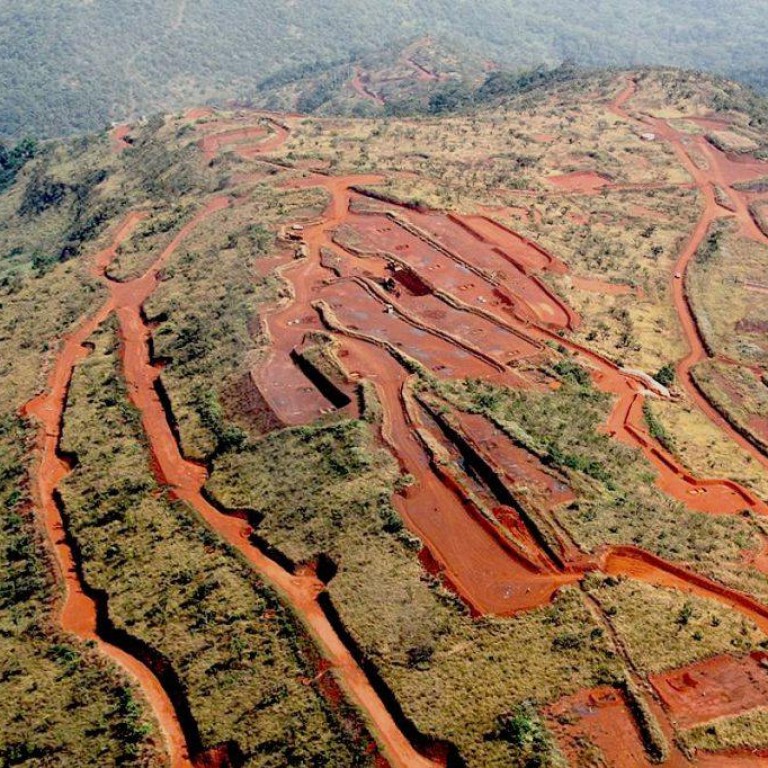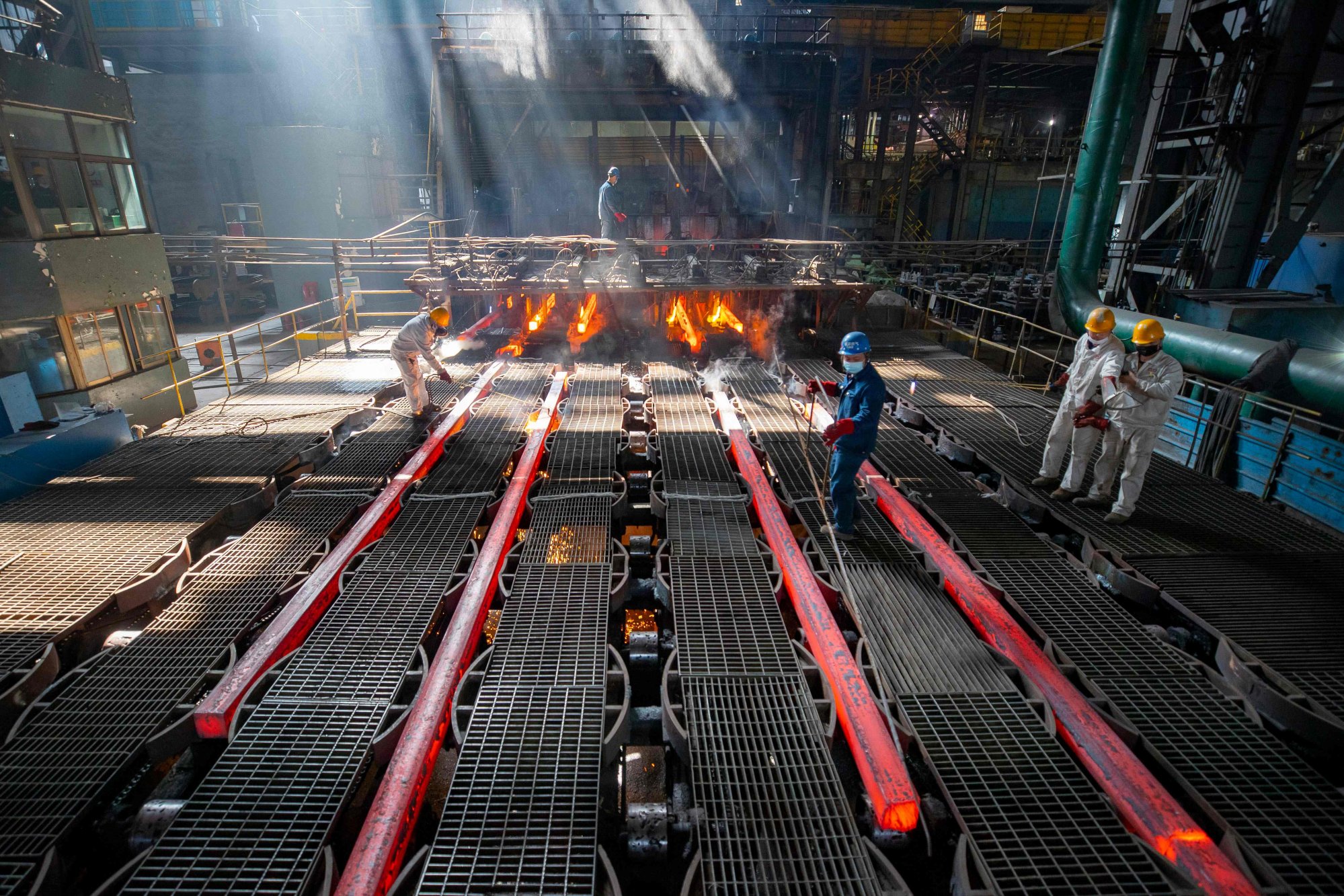
China looks to Guinea’s vast Simandou iron ore mine to secure supply
- Mine said to have world’s largest untapped high-quality reserve but has remained undeveloped because there is no railway line to transport the ore
- Baowu, China’s biggest iron and steel producer, is among those investing in the project at a time when the country is trying to diversify its supply
The mine – located in the Simandou mountain range of southern Guinea’s Nzérékoré region – is said to have the world’s largest untapped iron ore reserve of high quality, with an estimated 2.4 billion tonnes.
The deposits have drawn Chinese multinationals including China Baowu Steel Group, the country’s largest iron and steel producer.
In September, Baowu signed a deal with Société Minière de Boké (SMB)-Winning Consortium Simandou (WCS) to develop blocks 1 and 2 of the Simandou north project.
Singaporean shipowner Winning International Group, Chinese aluminium producer Shandong Weiqiao and the Guinean transport and logistics firm United Mining Suppliers International make up the consortium.

While the commercial-scale reserves of high-grade iron ore were confirmed back in 2002, the Simandou mine has remained undeveloped because there is no railway line to transport the ore from the remote corner of Guinea to the sea for export.
Baowu is now leading a group that would invest an undisclosed sum in the SMB-Winning Consortium to buy a 49 per cent stake in its two subsidiaries – WCS InfraCo, for infrastructure development, and WCS MineCo, to develop the mine.
The Chinese company plans to increase its shareholding in WCS MineCo to 51 per cent once the mine is operational, subject to regulatory approval.
Erik Hedborg, principal analyst at commodities consultancy CRU Group, said that since Baowu is China’s largest steelmaker and also a state-owned company it can be seen as a representative of the Chinese steel industry.
“With the company taking interest in Simandou, it is clear that the project has gained significant interest from the Chinese steel industry and from the Chinese authorities,” Hedborg said.
He said when Simandou started producing at full capacity it would become the world’s third-largest exporter of iron ore, behind Australia and Brazil, and would make up nearly 10 per cent of the global export market.
Hedborg said this would help to diversify iron ore supply for China and other regions, since Australia makes up 60 per cent of global exports and Brazil around 20 per cent. He said the two countries supplied nearly 85 per cent of China’s iron ore.
“China wants to diversify its iron ore supply and this is seen as a good opportunity to do so,” Hedborg said.
Baowu has a 20 per cent stake in Chalco, with 75 per cent owned by Aluminum Corporation of China and the remainder shared between China Rail Construction Corporation and China Harbour Engineering Company.
China warns security is at risk from external reliance on critical resources
The Simandou mine project has been delayed by years of ownership disputes and slow progress on the 650km (400-mile) railway needed to transport the ore to Guinean ports.
The move forced Rio Tinto and the SMB-Winning Consortium to establish a framework for the project’s infrastructure, including a railway line and a port.
That led to a new joint venture known as La Compagnie du TransGuinéen (The TransGuinean Company) – formed by the Guinean government, WCS and Rio Tinto Simfer – to develop the infrastructure.
“The Guinean government really wants Simandou to go ahead and when we visited the country in November, it was clear that the project is progressing and construction of the railway, port and other infrastructure is taking place,” according to Hedborg of CRU Group.
He said the junta had suspended operations at Simandou to push stakeholders to advance the project, and there had been progress since then “both on the ground and also in terms of establishing joint ventures and consortiums that will construct and operate the assets”.
Last month, Baowu said it had reached a consensus with WCS, Simfer and the Guinean government on the development of infrastructure such as railways and ports required for the whole Simandou project. But it said investment from the Baowu consortium would depend on government approvals from both China and Guinea.
Securing access to Simandou provides both security, over the supply of a critical mineral, and diversity away from an overwhelming dependence on Australia
The Guinean government called the agreement, signed on December 22, “an important milestone” that will allow the partners to start the process of financing the project – estimated at around US$15 billion.
In a statement, Guinea’s directorate of communication and information said the agreement was “strengthened” by the participation of Baowu, “whose arrival at the negotiating tables was welcomed by all stakeholders”.
Under the agreement, construction of the infrastructure is to be completed no later than December 31, 2024 and commissioned by March 13, 2025.
Gyude Moore, a senior policy fellow at the Centre for Global Development and former minister of public works in Liberia, said it appeared the investors and the junta had found a solution to the issues that led to the suspension of the project early last year.
“Simandou has already carried significant expectations for infrastructure development in Guinea, and the cost of that infrastructure – the rail and deep water port – has stymied investors,” Moore said.
He noted that China needed to diversify its sources of iron ore and reduce dependence on Australia. “Minerals will become increasingly important in the shift to net zero and there is a push to secure access to supplies,” he added.
China unveils plan for mineral ‘self-sufficiency’ as supply risks multiply
Baowu’s entry to the Simandou project could mean it finally takes off, according to Moore. “It will provide much-needed jobs, an infusion of cash and a source of export revenues,” he said. “Most importantly, the infrastructure investment should multiply other economic activities in the country.”
Moore said the volume and quality of the Simandou iron ore could have implications for the price of the metal.
“Securing access to Simandou provides both security, over the supply of a critical mineral, and diversity away from an overwhelming dependence on Australia,” he said.
Ties between China and Australia have been strained since Canberra called for an international investigation into the origin of the coronavirus, prompting Beijing to slap trade restrictions on a wide range of Australian exports. There are also tensions over human rights and national security concerns.
When completed, the Simandou project would at least double China’s iron ore imports from Africa, which accounted for about 4 per cent of the 1.12 billion tonnes the country imported in 2021.
Guinea also has rich reserves of bauxite, a key raw material for the aluminium industry. China is the biggest importer of the mineral.

